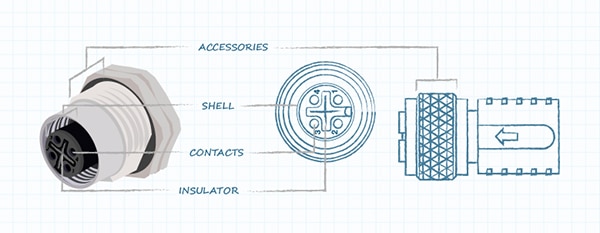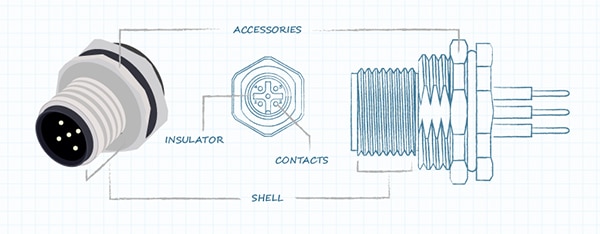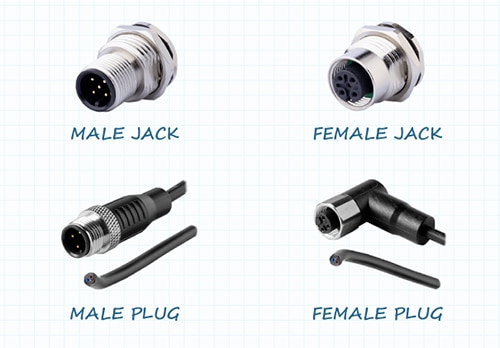An Introduction to Circular Connectors and Cables
2022-12-08
Housing multiple pins or contacts for transferring electrical power, signals, or data, circular connectors are cylindrical electrical devices of varying sizes that are designed to withstand a range of harsh environments. Also referred to as circular interconnects, their circular construction affords them additional ruggedness and resistance to vibration and impact damage, outside signals or interference, incursion from environmental contaminants, and pressure or temperature extremes.
Due to their high performance in these extreme conditions, circular connectors and cables find broad uses in industrial and factory automation applications, medical devices, security and defense systems, aerospace, and more. Circular connectors encompass a wide array of product offerings from standard circular connectors to DIN, Metric, Hermetic, Push-Pull, Keyed, Mixed Signal, and Micro or Nano versions. Hybrid options are also available that combine power, signal, and data into a single device. This article will primarily focus on standard circular connectors and cables, including their basic construction, designations and codes, selection criteria, and more.
Circular connector construction
Thanks to their cylindrical shape, circular connectors have a higher strength-to-weight ratio than any other connector shape. As already mentioned, this enhanced strength gives them added resistance to impact damage, outside elements, and decoupling, while giving them durability in applications with frequent mating cycles.
The number of internal contacts as well as the layout of those contacts varies by connector and application type to ensure correct alignment and insertion into a compatible mating device. Circular connector shells are often constructed with threads to allow for more secure screw-in connections where vibration or other factors would potentially cause unwanted decoupling. Other types of connection systems include bayonet locking, push/pull locking, and snap lock.
From a high level, each circular connector consists of four main areas (Figures 1 and 2):
 Figure 1: Basic construction of a female circular connector. (Image source: Same Sky)
Figure 1: Basic construction of a female circular connector. (Image source: Same Sky)
- Contacts: The internal pins and sockets housed in the connector used to form the electrical connection. A mated pair consists of male contacts and female sockets.
- Insulator: This component encapsulates the contacts and insulates them from each other and the connector shell. It also provides proper spacing of the contacts and holds them in the correct position.
- Shell: As the outer cover of the connector, the shell protects the contacts and insulator while providing the alignment and connection mechanism for pairing two connector halves.
- Accessories: These can include pins, keys, rings, clamps, gaskets, and additional components utilized to guide, secure, position, and seal parts of the connector.
 Figure 2: Basic construction of a male circular connector. (Image source: Same Sky)
Figure 2: Basic construction of a male circular connector. (Image source: Same Sky)
Common circular connector designations and codes
Perhaps the most well-recognized type of circular connector is the M-style standard utilized for connecting sensors and actuators in industrial network applications. “M” simply calls out the size of the metric thread on the coupling nuts and mating receptacles, which gives us the common M5 (5 mm diameter fasteners), M8 (8 mm), and M12 (12 mm) connector types. M12 circular connectors and cables are arguably the most common type found as they are a global standard for the automotive industry.
As a whole, M-style connectors are further divided into several categories that define the keying and shape of the contact body to ensure properly mated connections. These designations and codes are defined as follows (Figure 3):
- A – connectors for sensors, dc power and 1 Gbit Ethernet (protocol for connecting computer systems to form a network).
- B – connectors for Fieldbus (industrial computer network for distributed control) and Profibus (digital network standard providing communication between field sensors and a control system).
- C – connectors with a dual keyway for added security, used for ac power for sensors and actuators.
- D – connectors for 100 Mbit Ethernet and Profinet (protocol for data exchange between controllers and devices) systems.
- X – connectors for 10 Gbit Ethernet high speed applications as well as power over Ethernet (PoE).
- S – connectors for ac power (replacement for C – coded parts).
- T – connectors for dc power (replacement for A – coded parts).
 Figure 3: A general overview of the various interface options for M-style connectors. (Image source: Same Sky)
Figure 3: A general overview of the various interface options for M-style connectors. (Image source: Same Sky)
Circular connector selection criteria
There is a nearly endless list of specifications and considerations to take into account when selecting circular connectors and/or cables for a design. Outside of deciding whether a circular plastic connector (CPC) or circular metal-shell connector (CMC) is the better fit, here is a relatively comprehensive list of parameters to consider:
- Gender (Male/Female): The male end incorporates the contact pins that plug into the female sockets (Figures 4 and 5). Most plugs and receptacles are designed to mate within their own brand or manufacturer. Connectors from different manufacturers typically do not interconnect, so in general, connectors will be sourced as a mated pair.
 Figure 4: Mating of a male and female circular connector pair. (Image source: Same Sky)
Figure 4: Mating of a male and female circular connector pair. (Image source: Same Sky)
- Number of Contacts: The number of conductive pins in the connector required to carry the signals, data, or power. This number can range from 1 into the hundreds.
- Termination: How the wire or cable will mate with the conductive contacts in the connector, including solder, wire wrap, lugs, or crimping.
- Contact Size: The diameter of the individual contacts or gauge of wire that can mate with each contact.
- Voltage & Current Rating: The maximum voltage, expressed as volts (V), or current, expressed as amps (A), that the connector is designed to carry.
- Insertion Frequency: How often the connector will be connected and disconnected. Also known as mating cycles, the frequency of connection may require a more robust connector or cable protection accessory.
- Mounting Style: Common mounting options include cable mount, panel mount, or surface mount.
- Coupling or Locking Style: Offers secure mating of the connector and can include bayonet, latch, push-pull, threaded, and quick-disconnect.
- Backshell Type: Threaded onto the cable side of a circular connector to offer secure cable support, backshell types include straight, right angle, braid tail, spring, strain relief, sealed, and crimped.
- Materials Used: Common materials used for the connector body are stainless steel, aluminum, plastic, composite, or brass, depending on design requirements and budget.
- Ingress Protection: IP ratings are defined by the IEC 60529 standard that covers protection against solids and liquids entering the body of the connector. ANSI 60529 covers IP in the United States and EN 60529 covers it in Europe.
- Plugs & Sockets: There is no standard naming convention so different manufacturers may use alternate terms, but typically sockets and jacks are associated with panel mounted circular connectors, while plugs relate to circular connector cable assemblies.
 Figure 5: How to designate jacks and plugs of different genders (Image source: Same Sky)
Figure 5: How to designate jacks and plugs of different genders (Image source: Same Sky)
Conclusion
Will the connector be exposed to environmental contaminants or subject to immersion? Does the connector require protection from EMI or RFI signals? Will the connector be subject to excessive vibration or frequent impacts? The answers to each of these will help determine the quality, features, and accessories needed, but regardless, circular connectors have proven to be a reliable and rugged interconnect solution when dealing with harsh application conditions. Same Sky offers a diverse range of circular connectors and circular cable assemblies that can meet these design challenges head on.
Disclaimer: The opinions, beliefs, and viewpoints expressed by the various authors and/or forum participants on this website do not necessarily reflect the opinions, beliefs, and viewpoints of DigiKey or official policies of DigiKey.






